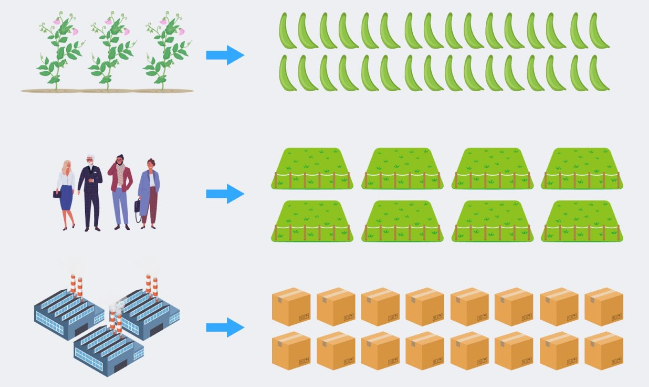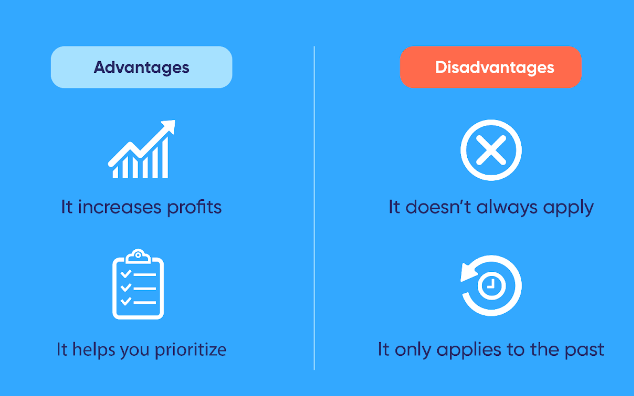

Do you focus on the big-picture objectives and prioritize tasks that help you move toward them?
Or do you feel more like a firefighter — constantly putting out small fires but never really making progress on your goals?
Juggling multiple priorities can lead to poor decisions, lack of efficiency, and burnout.
And if you don’t manage your time efficiently, you spend most of your time and energy on things that don’t get you the results you want.
If you’re tired of running around like a headless chicken, you might need the Pareto principle.
Also known as the 80 20 rule, the Pareto principle can help you prioritize the activities that really matter, so you can achieve more with less effort.
Read on to learn what the Pareto principle is and how you can apply it in business and in life to work more efficiently.
What is the Pareto principle?
The Pareto principle is an observation that, in general, 20% of the effort, or input, leads to 80% of the results or output.
It was discovered by Italian economist, engineer, and sociologist Vilfredo Pareto.
Pareto was born in Paris in 1848 but moved to Italy in 1858, where he undertook his studies. He received his doctorate in 1869 from the Polytechnic University in Turin.
His most famous observation led to him discovering what is now known as the Pareto principle, or the 80 20 rule.

The story goes that one day in his garden, Pareto noticed that only around 20% of his pea plants generated around 80% of the healthy pea pods.
Extending the observation beyond his vegetable patch, Pareto noticed that the wealth distribution in Italy also followed this principle. Eighty percent of the land was owned by 20% of the (wealthiest) families.
Looking at different industries, he observed that the principle applied there, too. In many cases, 80% of the production came from just 20% of the companies.
Although sometimes known as Pareto’s law, the 80/20 Pareto principle is an observation, not a mathematical law.
The 80/20 rule: What does it mean?
The Pareto efficiency, or 80/20 rule, states that 80% of the results come from 20% of the inputs.
This principle has been widely applied in business and economics to increase productivity.
You can also use it in your personal life to help you:
- Manage your time more efficiently
- Regulate healthy habits
- Achieve your goals
In 1992, the United Nations Human Development Report reported that 20% of the people owned 82.7% of the wealth. It was the first time in recorded history this had been shown.
The United Nations used the form of a champagne glass to symbolize this distribution.

This was another example of the Pareto principle occurring in real life.
Pareto’s observation in business
To this day, we can still observe the Pareto distribution in many aspects of business. In general:
- 80% of expenses go to 20% of the goods or services
- 80% of revenue comes from 20% of the clients
- 80% of sales are from 20% of the products
- 80% of sales are also from 20% of sales personnel
For this reason, the Pareto principle can apply in many aspects of business, including:
- Management
- Human resources
- Marketing strategy
- Customer service
Pareto analysis can help you reorient your business strategy to focus on the most crucial areas.
Start by identifying the 20% of the inputs that generate 80% of the outputs in different aspects of your business.
For example, by identifying which clients generate the most revenue, you can focus your marketing and customer service efforts on them.
And when looking for new clients, you can target people with profiles similar to those of your most loyal customers.
Focusing most of your attention on the top 20% can maximize the efficiency of your business and protect your core revenue streams.
However, that does not mean you should neglect the other 80%. Continue to dedicate time and resources to them, but less.
What is a Pareto chart?
A Pareto chart — also known as a Pareto diagram — is a way to visualize and analyze data using the Pareto principle.
It’s a type of bar chart that shows the importance of different situations or inputs in descending order.

The longest bar appears on the left, signifying the most important input or issue.
A Pareto diagram can help you:
- Analyze different situations, problems, or causes and establish the most important ones
- Analyze data regarding the frequency of problems in a process
- Communicate results or information using data
- Analyze specific components of problems or broad causes
Advantages and disadvantages of the 80/20 Pareto principle
Like any business analysis tool, the Pareto principle has both its uses and its drawbacks.
Let’s take a look at the main advantages and disadvantages of the 80 20 rule.

Advantage: it can increase profits
Applying the Pareto principle to your business can lead to an increase in productivity and profits.
For example, knowing that 80% of sales are made by 20% of your sales associates indicates where you should focus your attention and resources.
Reassigning high-performing salespeople to your biggest accounts and boosting their skills through training can increase your revenue.
Similarly, the 80/20 rule can help you identify the 20% of your clients or customers who are responsible for the majority of your sales and focus your marketing efforts on them.
It can also highlight the 20% of your products or services that generate 80% of your revenue, so you can offer more of those.
Disadvantage: it doesn’t always apply
The Pareto principle is not a mathematical law. It is a general observation, but that doesn’t mean it’s true in every case.
Natural variations of the Pareto principle can occur. For example, 30% of your salespeople might be responsible for 60% of your sales.
Furthermore, it can be easy to misinterpret. People often think that they should focus all their attention on the 20% and completely forget about the rest.
But this is a mistake.
While you might focus most of your attention on the 20% of your clients who support your business most, you shouldn’t neglect the other 80%.
If you do, you risk losing them, and they will never have the chance to become part of the 20%.
Advantage: it helps you prioritize
Using the Pareto principle, you can prioritize your tasks by deciding what to focus your attention on. This enables you to delegate or let go of everything else.
When you identify the 80%, you can start to get to the root of any problems.
This can help you iron out kinks and increase your revenue.
Likewise, it helps you identify bottlenecks and get to the root cause of problems. This can also have a positive impact on your profits.
Disadvantage: it only applies to the past
A Pareto analysis is only a reflection of the data from the past. Although it can be a useful rule-of-thumb when planning, it doesn’t make projections for the future.
While past performance can be a good indicator of future performance, it’s not always relevant.
Circumstances can change and evolve, meaning the Pareto principle is not always useful for designing strategies for the future.
6 Pareto principle examples
Now you know the theory, it’s time to put it into practice.
Here are six real-world Pareto principle examples of how to achieve more while doing less:
1. Warehouses with large inventories
In a warehouse, applying the 80/20 rule can help you identify the 20% of the goods that generate 80% of the movements and sales.
Prioritize these items by featuring them on your website, in your marketing material, and in your brick-and-mortar store, if you have one.
2. General management
In many teams, 20% of the employees account for 80% of the outputs.
Use the Pareto principle to single out your least productive employees and help them improve their performance.
This will reduce the gap between the most and least efficient members of your team.
3. Quality control
Pareto diagrams are particularly useful in quality control and management.
They give you a visual representation of the 20% of problems that negatively impact 80% of the processes.
The graph can help you identify all the elements that combine to form the problem. You can also see which problems generate the most errors.
4. Sales and marketing
The Pareto principle works well for digital marketers. This is because they have access to data and analytics tools that give insights into the performance of their campaigns.
Armed with this information, you can use the 80/20 rule to improve your digital marketing strategy.
Knowing that 20% of your posts generate 80% of your traffic, identify which types of posts perform best.
Then, design a content marketing strategy that incorporates more similar posts.
5. IT networks
Network technicians can apply the Pareto distribution to identify the 80% of risks that derive from 20% of the security controls.
This allows you to reinforce only a small number of necessary controls while protecting the network from the majority of threats.
6. Occupational health and safety
In health and safety, 20% of risks could be responsible for producing 80% of workplace accidents.
For example, one study by the Transportation Research Safety Board found that 20% of drivers were involved in 79% of all traffic accidents and 76% of all violations.
By controlling and resolving a limited number of hazards, you can prevent the majority of accidents.
Applying the Pareto principle to health and safety can also save your company money. There is a greater return on investment for the cost of the prevention measures, and the costs associated with accidents are reduced.
The Pareto principle helps you do more with less
The Pareto principle is a business analysis tool that can help you redirect your resources for maximum efficiency and output.
When applied correctly, the 80/20 rule can reduce your overall workload while increasing productivity.
This leaves you with more time and energy to dedicate to the things that really matter in your business.









You must be logged in to post a comment Login